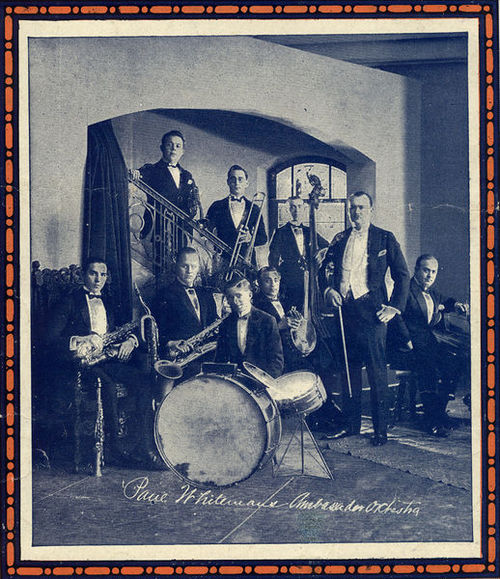Информация об исполнителе
Paul Samuel Whiteman (March 28, 1890 December 29, 1967) was an American bandleader and orchestral director.
Leader of the most popular dance bands in the United States during the 1920s, Whiteman's recordings were immensely successful, and press notices often referred to him as the "King of Jazz". Using a large ensemble and exploring many styles of music, Whiteman is perhaps best known for his blending of symphonic music and jazz, as typified by his 1924 commissioning and debut of George Gershwin's jazz-influenced "Rhapsody In Blue". Whiteman recorded many jazz and pop standards during his career, including "Wang Wang Blues", "Mississippi Mud", "Rhapsody in Blue", "Wonderful One", "Hot Lips", "Mississippi Suite", and "Grand Canyon Suite". His popularity faded in the swing music era of the 1930s, and by the 1940s Whiteman was semi-retired from music.
Whiteman's place in the history of early jazz is somewhat controversial.[1] Detractors suggest that Whiteman's ornately-orchestrated music was jazz in name only (lacking the genre's improvisational and emotional depth), and co-opted the innovations of black musicians.[1] Defenders note that Whiteman's fondness for jazz was genuine (he worked with black musicians as much as was feasible during an era of racial segregation),[1] that his bands included many of the era's most esteemed white jazz musicians, and argue that Whiteman's groups handled jazz admirably as part of a larger repertoire.[2] In his autobiography, Duke Ellington[3] declared, "Paul Whiteman was known as the King of Jazz, and no one as yet has come near carrying that title with more certainty and dignity."
User-contributed text is available under the Creative Commons By-SA License and may also be available under the GNU FDL.
Leader of the most popular dance bands in the United States during the 1920s, Whiteman's recordings were immensely successful, and press notices often referred to him as the "King of Jazz". Using a large ensemble and exploring many styles of music, Whiteman is perhaps best known for his blending of symphonic music and jazz, as typified by his 1924 commissioning and debut of George Gershwin's jazz-influenced "Rhapsody In Blue". Whiteman recorded many jazz and pop standards during his career, including "Wang Wang Blues", "Mississippi Mud", "Rhapsody in Blue", "Wonderful One", "Hot Lips", "Mississippi Suite", and "Grand Canyon Suite". His popularity faded in the swing music era of the 1930s, and by the 1940s Whiteman was semi-retired from music.
Whiteman's place in the history of early jazz is somewhat controversial.[1] Detractors suggest that Whiteman's ornately-orchestrated music was jazz in name only (lacking the genre's improvisational and emotional depth), and co-opted the innovations of black musicians.[1] Defenders note that Whiteman's fondness for jazz was genuine (he worked with black musicians as much as was feasible during an era of racial segregation),[1] that his bands included many of the era's most esteemed white jazz musicians, and argue that Whiteman's groups handled jazz admirably as part of a larger repertoire.[2] In his autobiography, Duke Ellington[3] declared, "Paul Whiteman was known as the King of Jazz, and no one as yet has come near carrying that title with more certainty and dignity."
User-contributed text is available under the Creative Commons By-SA License and may also be available under the GNU FDL.
показывать / спрятать больше







 |
|

